
For this edition of Classic Steel, we are going to take a look back at Kawasaki’s all-new 2003 KX250.
 All-new for 2003, Kawasaki’s redesigned KX250 looked to reclaim the lost glory of its 1990s predecessors. Photo Credit: Kawasaki
All-new for 2003, Kawasaki’s redesigned KX250 looked to reclaim the lost glory of its 1990s predecessors. Photo Credit: Kawasaki
The mid-to-late nineties were a great time to be riding green in the 250 class. As Honda experimented with aluminum frame construction and Suzuki and Yamaha tried to figure out where their horsepower went, Kawasaki pulled to the front of the class with brutally effective 250 weapons. Well-suspended, decent handling and blessed with the motor of doom, these late nineties KXs were the machines to have at the time.
 A new frame for 2003 (2002 on the left, 2003 on the right) slimmed the mid-section, compacted the riding compartment and tightened the handling. Photo Credit: Kawasaki
A new frame for 2003 (2002 on the left, 2003 on the right) slimmed the mid-section, compacted the riding compartment and tightened the handling. Photo Credit: Kawasaki
As we transitioned into the new millennium, however, the balance of power began to shift. Honda started to figure out its alloy frame construction and Yamaha finally perfected their Jack-of-all-trades formula by producing a machine that did everything well and nothing poorly. As Honda and Yamaha ascended, Kawasaki began to fall behind. Engine changes aimed at making the KX easier to manage neutered its horsepower advantage and its once-innovative steel perimeter frame started to feel like a handicap. Wide, tall, and heavy, this frame made the bike feel bigger and less nimble than the competition.
 An all-new linkage on the KX125 and KX250 for 2003 lowered the ride height to increase traction and improve handling. Photo Credit: Kawasaki
An all-new linkage on the KX125 and KX250 for 2003 lowered the ride height to increase traction and improve handling. Photo Credit: Kawasaki
By 2002, it had become apparent that the KX250 was in need of a major redo. The ‘02 machine finished last against all of its Japanese competition and struggled to edge out the notoriously flawed no-link KTM 250SX. Slow, heavy, and poorly suspended, the KX250 had taken a mighty fall from the heights of its late-nineties success.
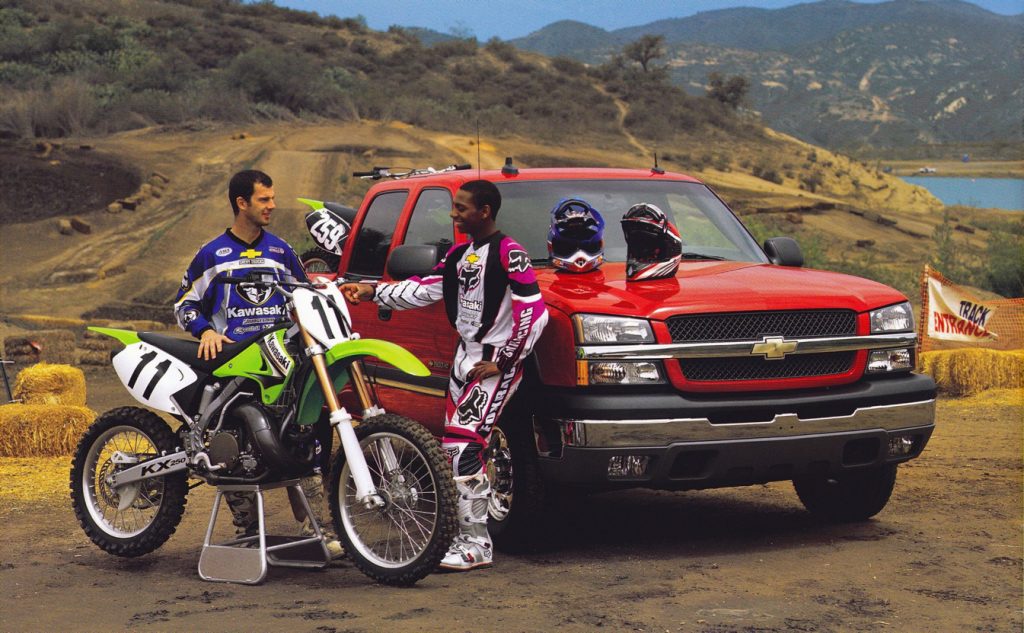 Factory Kawasaki had Ezra Lusk and James Stewart on the all-new KX250 and KX125 in 2003. Photo Credit: Kawasaki
Factory Kawasaki had Ezra Lusk and James Stewart on the all-new KX250 and KX125 in 2003. Photo Credit: Kawasaki
After the ignominious drubbing it had taken in ’02, it was back to the drawing board for the KX250 in 2003. In order to pull their deuce-and-a-half out of the cellar, Kawasaki’s engineers dialed up a virtually clean sheet design for ’03. Highlighting the package were an all-new chassis, redesigned suspension, and sleek new bodywork. Unfortunately, with the KX125 also receiving a major update (with an all-new motor) for ‘03, the new KX250 would have to soldier on two more years with the outgoing motor design. Still, the engineers dialed up an extensive list of refinements to the once-proud engine in hopes of recapturing the lost glory of the past. Slimmer, sleeker and mostly all new, the KX250 marched into 2003 with a great deal of anticipation from the Kawasaki faithful.
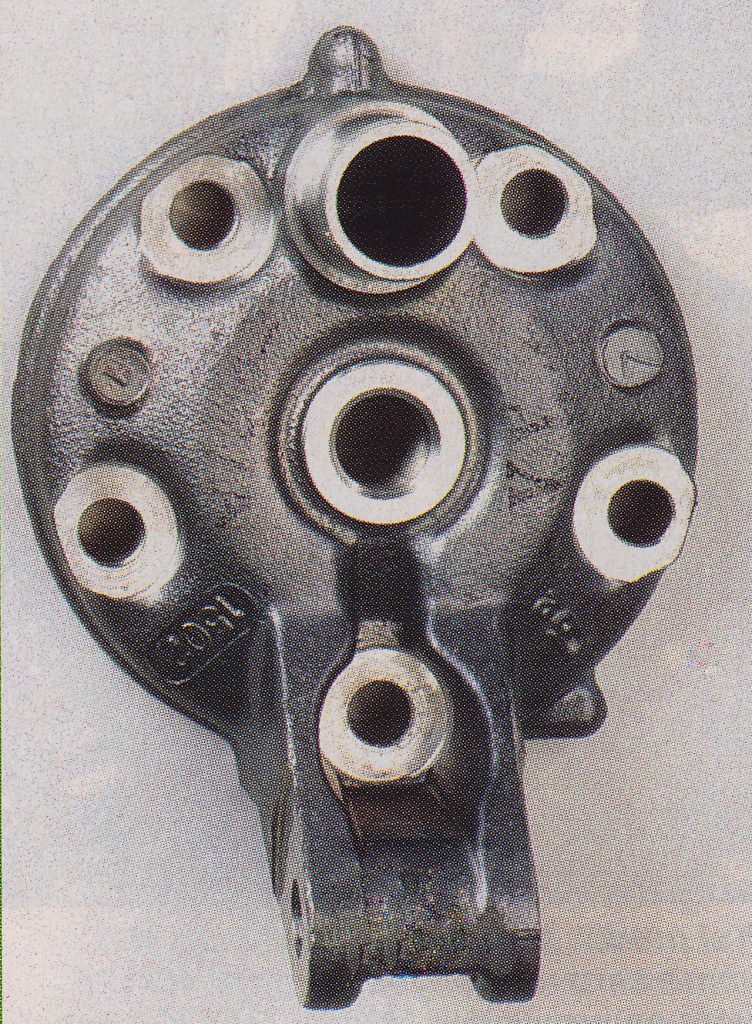 A new head for 2003 reversed the head stay from the front of the motor to the rear, and added an O-ring gasket for improved reliability. Photo Credit: Kawasaki
A new head for 2003 reversed the head stay from the front of the motor to the rear, and added an O-ring gasket for improved reliability. Photo Credit: Kawasaki
In 1990, Kawasaki became the first manufacturer to employ a perimeter frame for motocross. At the time, this now-ubiquitous chassis design was unproven in off-road use and quite a leap in technology. The perimeter chassis was ultra-stiff and far more resistant to torsional flex than a traditional frame. While strong, these early steel versions were also larger, heavier, and far bulkier than any of the single-backboned frames used by the competition.
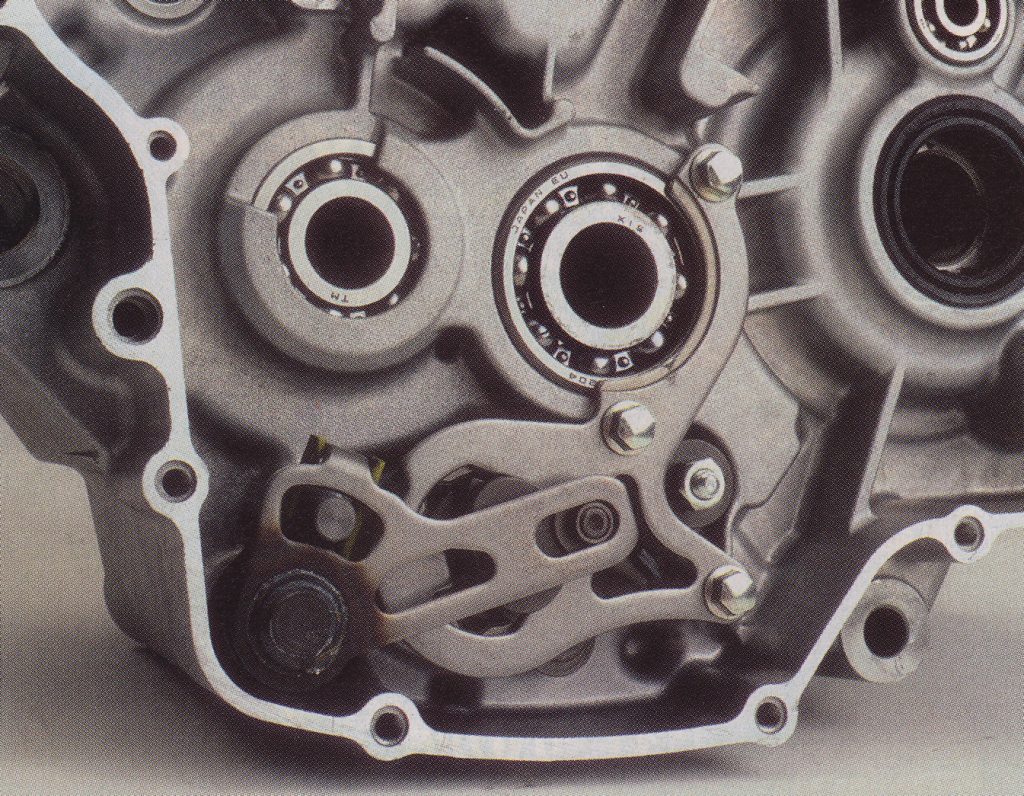 A new “ratchet-style” shift mechanism aimed to improve shift action for 2003. Photo Credit: Kawasaki
A new “ratchet-style” shift mechanism aimed to improve shift action for 2003. Photo Credit: Kawasaki
For 2003, Kawasaki looked to do away with this bulky feel by totally redesigning their perimeter chassis. The new frame remained formed from steel but featured a much more compact design. Coined the “New Generation Perimeter Frame” (NGPF) by Kawasaki, this new chassis was narrower through the middle, stiffer overall and more compact in every direction. The geometry was also all new, with a steeper steering head angle (one degree steeper than ’02) and more offset in the clamps (25mm vs. 22mm in ’02). Bolted to the NGPF was an all-new swingarm that was hydroformed for strength and tapered to save weight. A new Uni-Trak linkage was also spec’d that used fewer moving parts to further save a few precious ounces. In addition to being lighter, the new linkage lowered the ride height in the rear to improve weight balance and increase traction.
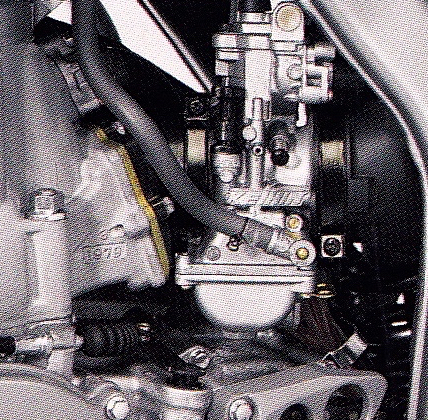 A new PWK38S carburetor featured Kawasaki’s K-TRIC throttle position sensor and a “powerjet” for improved throttle response and a cleaner burn. Photo Credit: Kawasaki
A new PWK38S carburetor featured Kawasaki’s K-TRIC throttle position sensor and a “powerjet” for improved throttle response and a cleaner burn. Photo Credit: Kawasaki
In addition to the new frame and linkage, new hubs were bolted on that were lighter and stronger, while featuring a larger axle (20mm to 25mm) in the rear for improved handling. The rear rotor was also increased in diameter (220mm to 240mm) to improve braking power. To offset any weight gain, the rotor was decreased in thickness and a new integrated rear master cylinder was employed that simplified packaging and saved a few additional ounces. Even the shock spring was redesigned for 2003 to save weight, with the new coil saving 300 grams (9 ounces) over 2002. Overall, all the weight-saving steps added up to a full four pounds being shed off the KX250 for 2003.
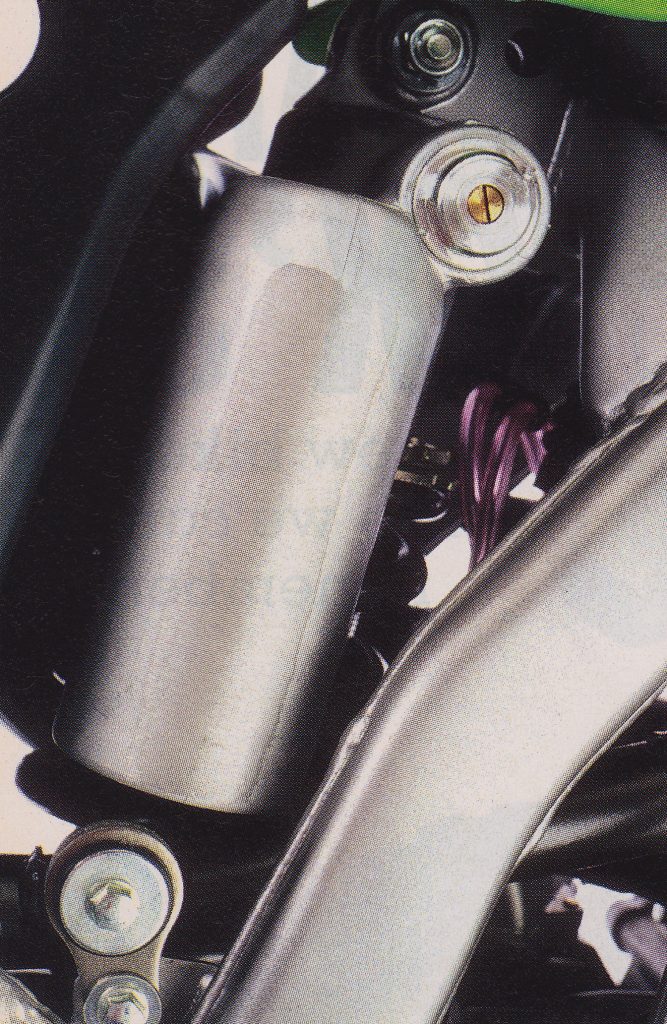 Back to basics: An all-new Kayaba shock for ’03 removed the separate high-speed compression adjuster to simplify tuning. Photo Credit: Kawasaki
Back to basics: An all-new Kayaba shock for ’03 removed the separate high-speed compression adjuster to simplify tuning. Photo Credit: Kawasaki
On the suspension end, the new KX featured a step back in technology both front and rear. In 1999, Kawasaki had been the first manufacturer to introduce separate controls for the high and low-speed compression damping on the rear shock. This gave riders an added level of control, but also led to many racers to getting lost in the weeds of suspension setup. For 2003, Kawasaki simplified things by ditching the high-speed selector and going back to a single compression adjustment. As in previous years, a single adjustor for rebound damping remained.
 At the second round of the 2003 Supercross season, Ezra Lusk took the new KX250 to a very popular win. This was his first victory in nearly four years and would turn out to be the last of his illustrious career. Photo Credit: Simon Cudby
At the second round of the 2003 Supercross season, Ezra Lusk took the new KX250 to a very popular win. This was his first victory in nearly four years and would turn out to be the last of his illustrious career. Photo Credit: Simon Cudby
Up front, Kawasaki once again took a step back in time by ditching the “bladder-style” forks they had employed since 2000 in favor of the more old-fashioned (but more proven) “bumper-style” mid-valve used on the YZ250. The sliders remained 48mm in size and featured adjustments for both compression and rebound damping.
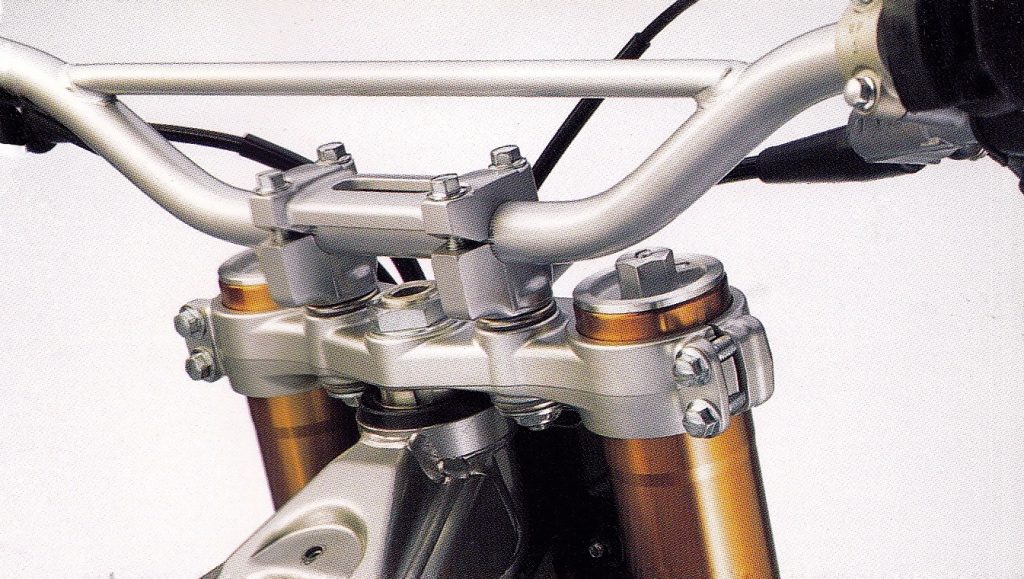 A one-degree steeper head angle and new clamps with 3mm more offset tightened up the KX’s handling for 2003. Photo Credit: Kawasaki
A one-degree steeper head angle and new clamps with 3mm more offset tightened up the KX’s handling for 2003. Photo Credit: Kawasaki
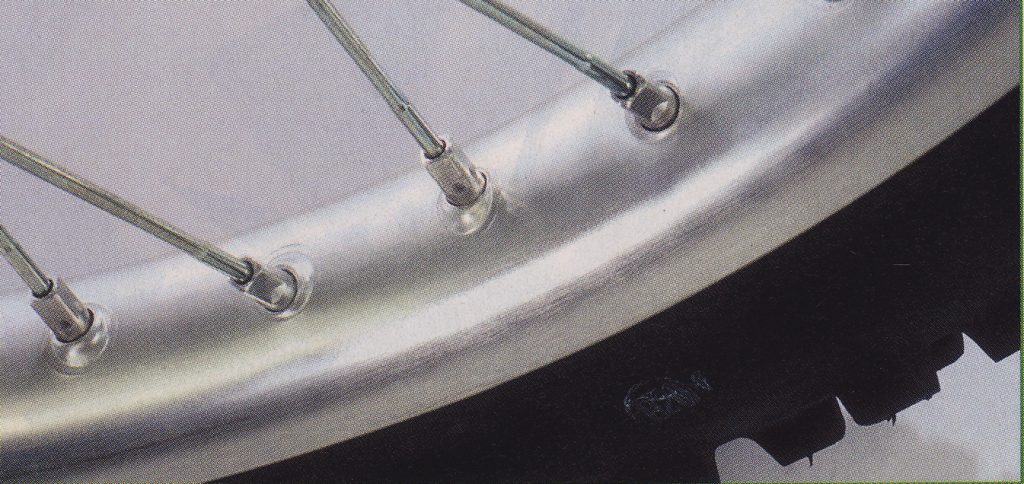 For 2003, the KX125 dropped the rather odd-looking shoulder-less rim it had used in 2002 and moved it over to the KX250. By 2005, this weird experiment in design would be retired to the ash heap of history. Photo Credit Kawasaki
For 2003, the KX125 dropped the rather odd-looking shoulder-less rim it had used in 2002 and moved it over to the KX250. By 2005, this weird experiment in design would be retired to the ash heap of history. Photo Credit Kawasaki
On the motor front, the KX250 had to make do with minor refinements for 2003. The lower cases and overall layout were unchanged, but Kawasaki did make several updates aimed at beefing up its anemic output. Internally, Kawasaki revised the porting, lowered the compression and retimed the KIPS (Kawasaki Integrated Power-valve System) to open 500rpm sooner. The crank was also lightened for quicker response and a new set of bearings were installed for improved reliability. In the transmission, a new ratchet-style shift mechanism looked to smooth out engagement and a new set of gears widened the gap between second and third. Finishing off the power package were a pair of larger radiators, a new ignition, and an all-new exhaust system.
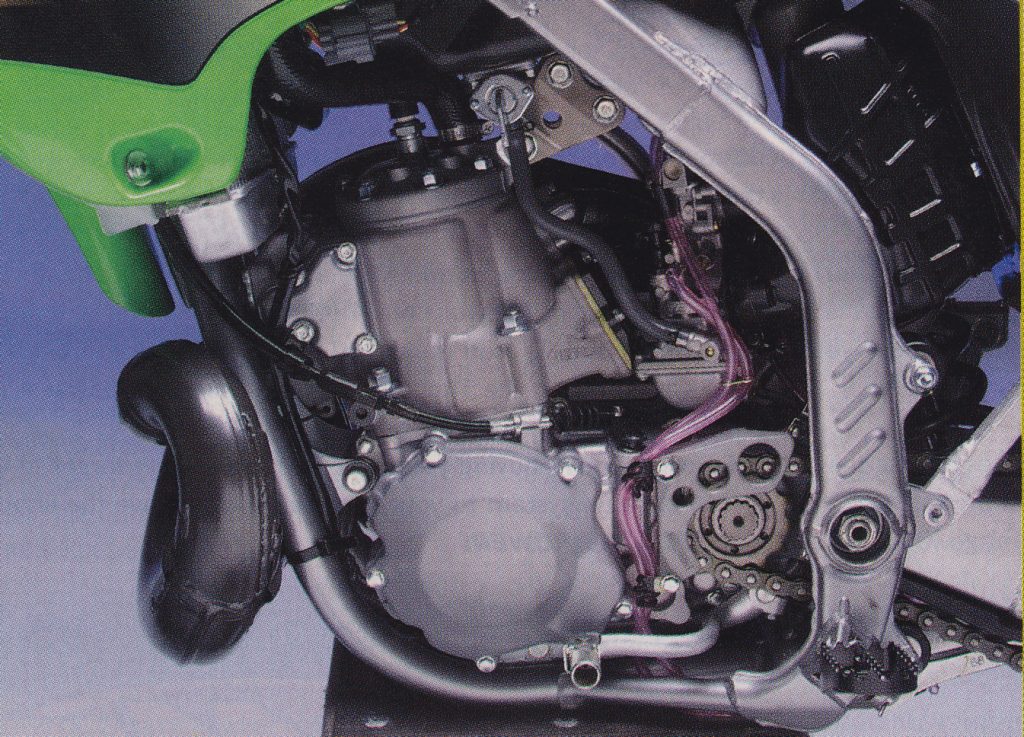 New porting, a revised KIPS, a lighter crank and a redesigned head added up to an improved, but not class-leading motor on the ’03 KX250. Low-end power was strong, but the motor tapered off quickly after that initial burst. Photo Credit: Dirt Bike
New porting, a revised KIPS, a lighter crank and a redesigned head added up to an improved, but not class-leading motor on the ’03 KX250. Low-end power was strong, but the motor tapered off quickly after that initial burst. Photo Credit: Dirt Bike
On the track, all these motor enhancements added up to an improved power package. Low-end response was substantially improved over 2002, with the KX snapping to attention at the slightest crack of the throttle. Off the line, the new Kwacker exploded forward with a strong surge that brought back fond memories of the late-nineties shootout winners. That pull carried over into a healthy midrange, before hitting a wall as the KX’s dyno curve fell off the proverbial cliff. Past the low-to-mid surge, the KX was a 220-pound weakling. At 9000 rpm, the ’03 KX250 gave up a whopping 12 horsepower to the class-leading YZ250.
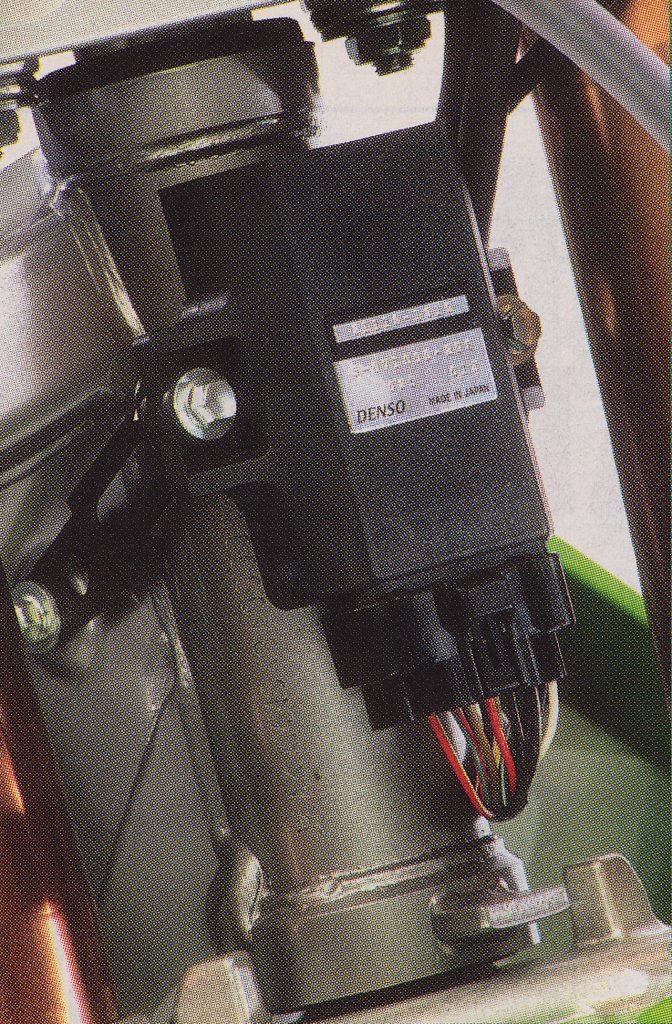 For 2003, Kawasaki moved the black box from the airbox (where it was always in the way) to a much more convenient location behind the front number plate. Photo Credit: Kawasaki
For 2003, Kawasaki moved the black box from the airbox (where it was always in the way) to a much more convenient location behind the front number plate. Photo Credit: Kawasaki
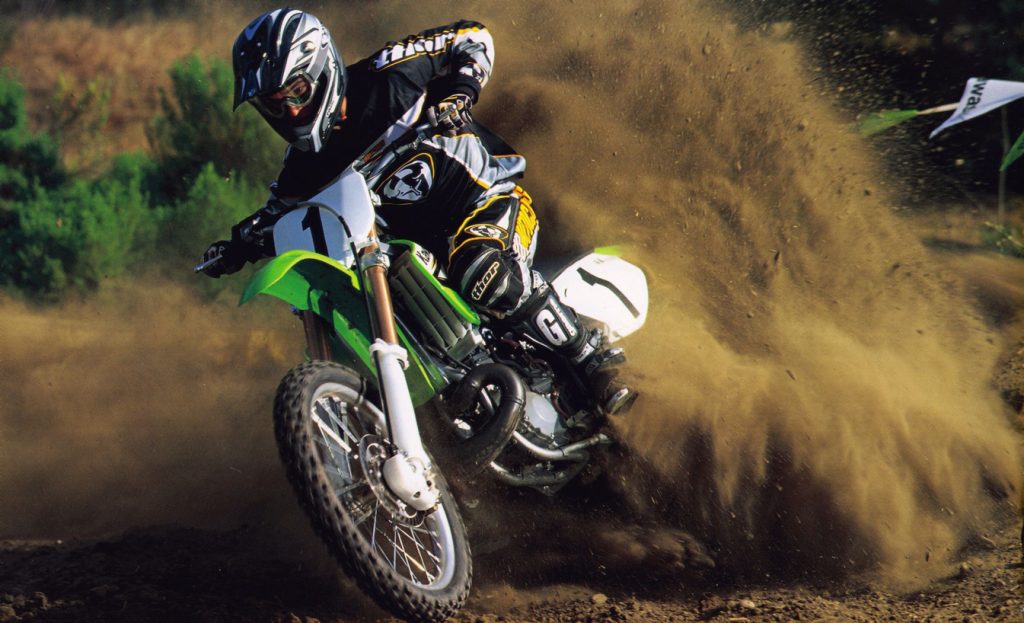 With its improved ergonomics, lighter feel, punchier motor and tighter handling, the ’03 KX was great at shredding corners. Photo Credit: Kawasaki
With its improved ergonomics, lighter feel, punchier motor and tighter handling, the ’03 KX was great at shredding corners. Photo Credit: Kawasaki
On short courses and from turn-to-turn, the KX was competitive, but once the track opened up, it was time to wave sayonara to the red, yellow and blue competition. All three offered more top-end power and could easily pull the KX in high-speed sections. On the KX, the best strategy was to use its perfect jetting (best in the class in ’03), improved shifting and snappy power to pull the others out of the turns, and then ride a very wide bike down the straights. Overall, it was much more competitive than the anemic ’02 mill, but still not up to running with the others on fast circuits.
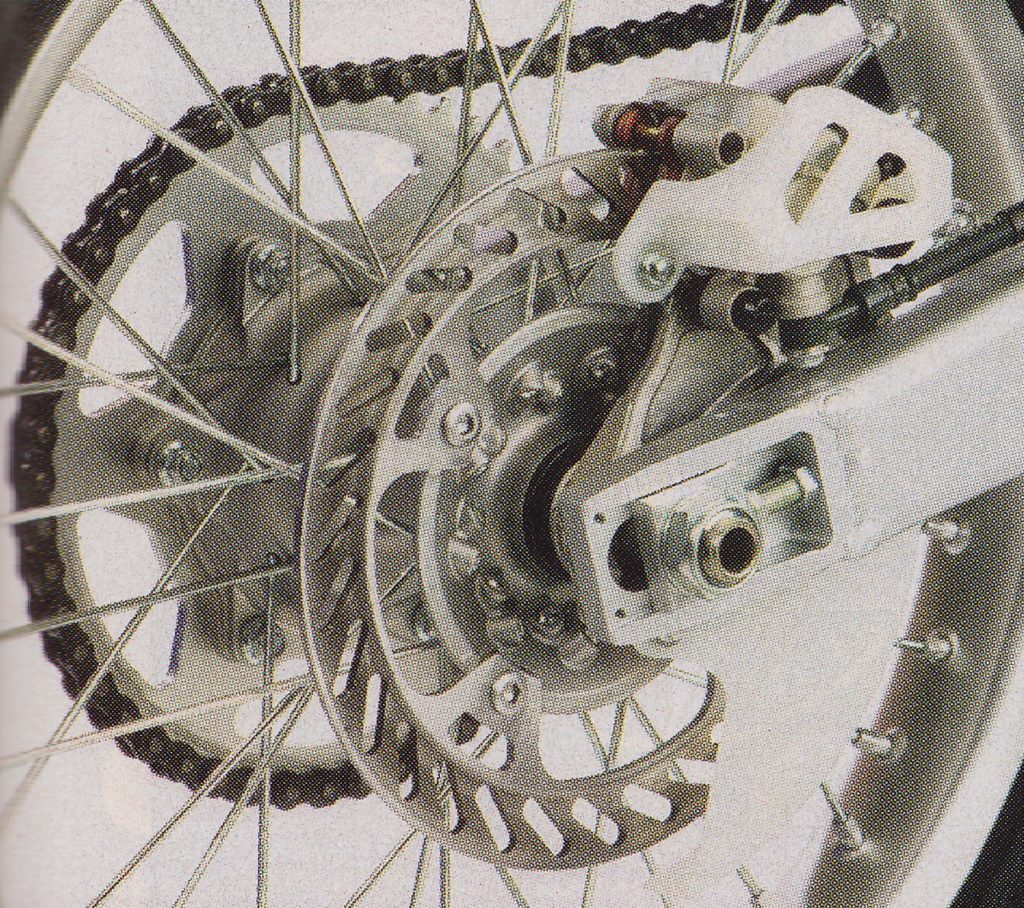 All-new hubs for 2003 were lighter, stronger, and accepted larger axles for improved handling and durability. Photo Credit: Kawasaki
All-new hubs for 2003 were lighter, stronger, and accepted larger axles for improved handling and durability. Photo Credit: Kawasaki
While the new/old motor turned out to be a bit of a disappointment, the rest of the ’03 KX proved to be a substantial improvement in performance. The new chassis was much narrower and less top-heavy feeling than past KX efforts. Turning was substantially improved and the KX felt much lighter than its four-pound weight savings would imply. Instead of looking for berms to bank off of, ’03 KX pilots could finally go to the inside and have a shot at pulling off the pass. It was still not going to cut under a Suzuki, but at least it was no longer a big green locomotive in the turns.
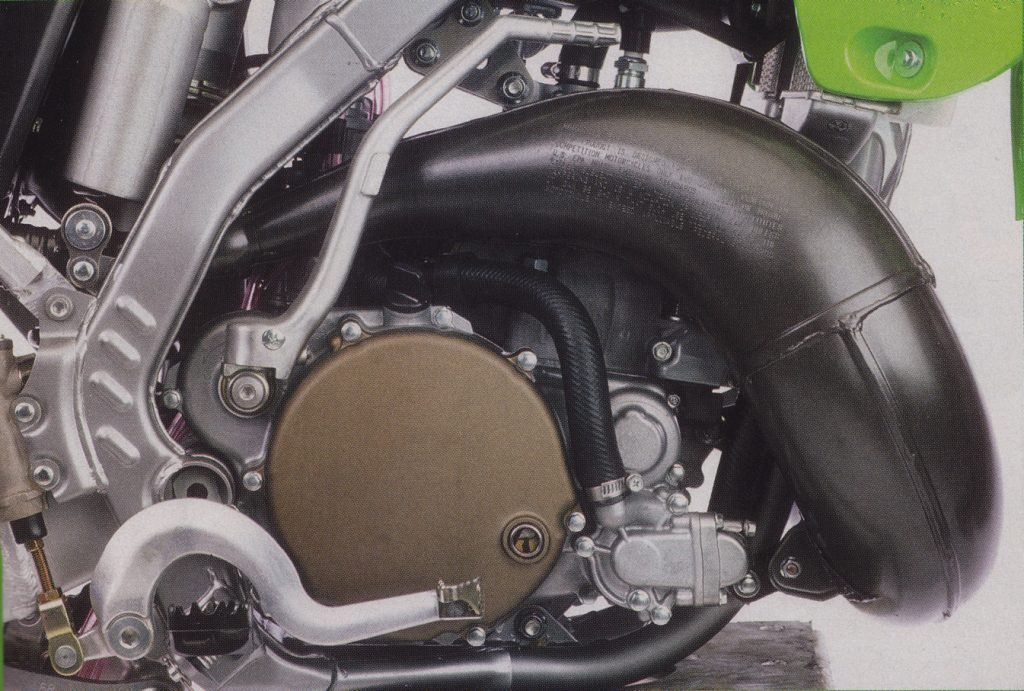 The factory-looking bronze coating on the KX’s clutch cover looked great on the showroom floor, but only lasted about one ride before looking beat to hell. The sano pipe coating, on the other hand, looked great when new and stayed that way far longer than traditional pipe coatings. Photo Credit: Dirt Bike
The factory-looking bronze coating on the KX’s clutch cover looked great on the showroom floor, but only lasted about one ride before looking beat to hell. The sano pipe coating, on the other hand, looked great when new and stayed that way far longer than traditional pipe coatings. Photo Credit: Dirt Bike
 Chevy Truck days: Ezra Lusk’s factory SR250 was one of the best-looking machines in the pits in 2003. Photo Credit: Dirt Rider
Chevy Truck days: Ezra Lusk’s factory SR250 was one of the best-looking machines in the pits in 2003. Photo Credit: Dirt Rider
Unfortunately, the flip side of this newfound turning prowess was a bit of headshake at speed. It was not going to make you pull out your Saint Christopher medal like an early-nineties Honda, but there was a bit more pucker factor at speed than traditional Kawasaki enthusiasts expected. The new chassis was also a bit cramped for those over six feet tall. If you were not built like Ricky or Bubba, then a taller seat and reversing the bar mounts were a good idea.
 The switch from bladder to bumper (with a mid-valve) forks in 2003 yielded an improved feel and smoother performance. Compliant on small stuff, the stock damping and spring settings were great on braking bumps, but too soft for serious aerial maneuvers. Photo Credit: Kawasaki
The switch from bladder to bumper (with a mid-valve) forks in 2003 yielded an improved feel and smoother performance. Compliant on small stuff, the stock damping and spring settings were great on braking bumps, but too soft for serious aerial maneuvers. Photo Credit: Kawasaki
On the suspension front, the action was much improved both front and rear. The new 48mm Kayaba bumper forks proved far plusher than the harsh 2002 bladder-equipped versions. They were super comfy on small chop and good at handling medium-sized hits. With the stock springs, they were too soft for Stew-sized leaps, but with an upgrade in springs, they were in the ballpark for most mere mortals.
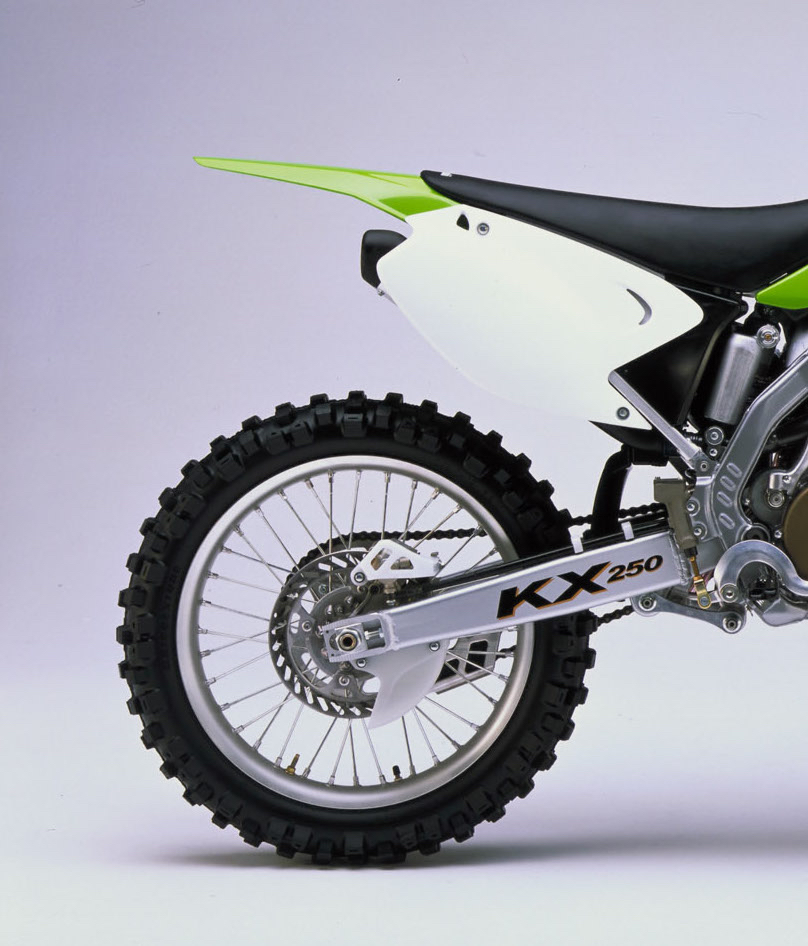 Like the forks, the new Kayaba shock was plush, but very soft. For anyone above the novice class, a spring swap and revalve was probably advisable. Photo Credit: Kawasaki
Like the forks, the new Kayaba shock was plush, but very soft. For anyone above the novice class, a spring swap and revalve was probably advisable. Photo Credit: Kawasaki
Out back, the new high-speed-less KYB damper provided a similarly plush feel. It was excellent in slow sections and great at braking bumps and moderate whoops, but too soft for major aerial maneuvers. The bottoming feel was good front and rear, so you didn’t get any jarring metal-to-metal clanks when the travel was used up, but the black marks on the bottom of the fenders were sure indications of the stock spring’s limitations.
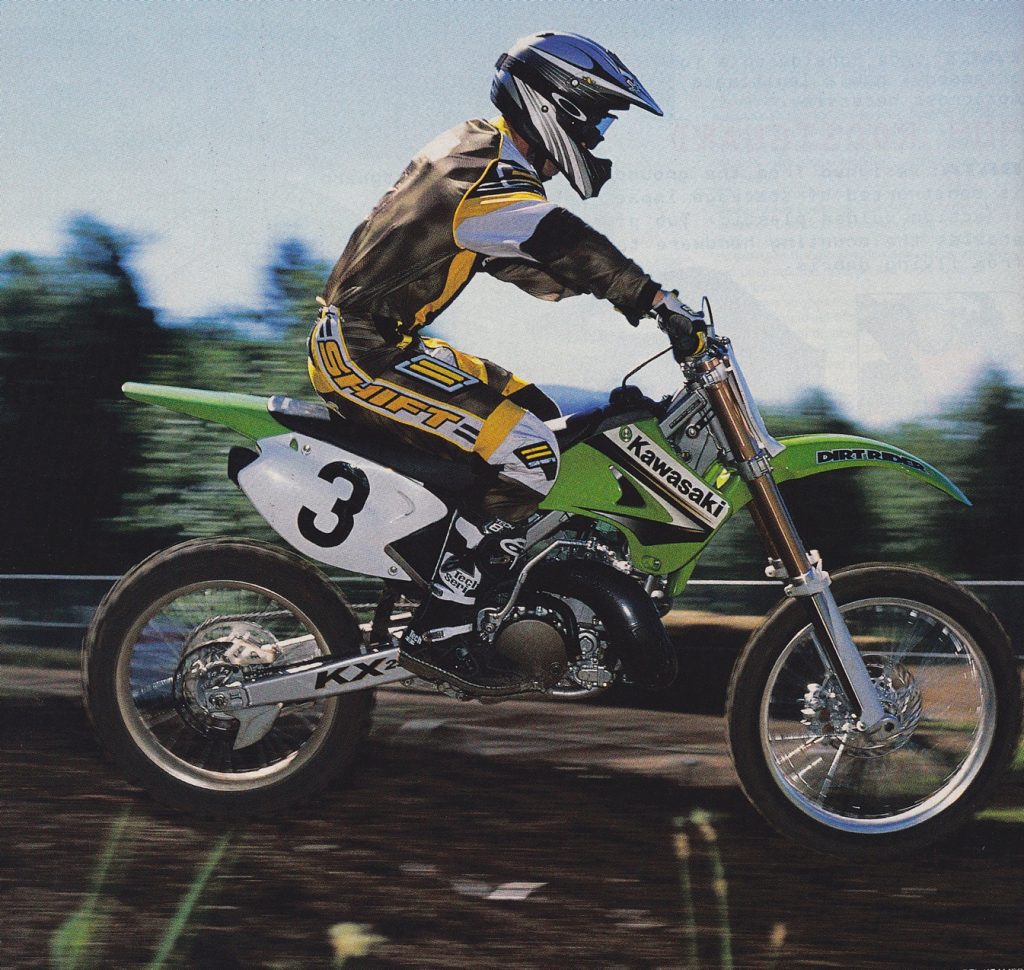 For pros like Jeff Emig, the stock KX250 was going to need major motor and suspension work to be competitive in 2003. Photo Credit: Kawasaki.
For pros like Jeff Emig, the stock KX250 was going to need major motor and suspension work to be competitive in 2003. Photo Credit: Kawasaki.
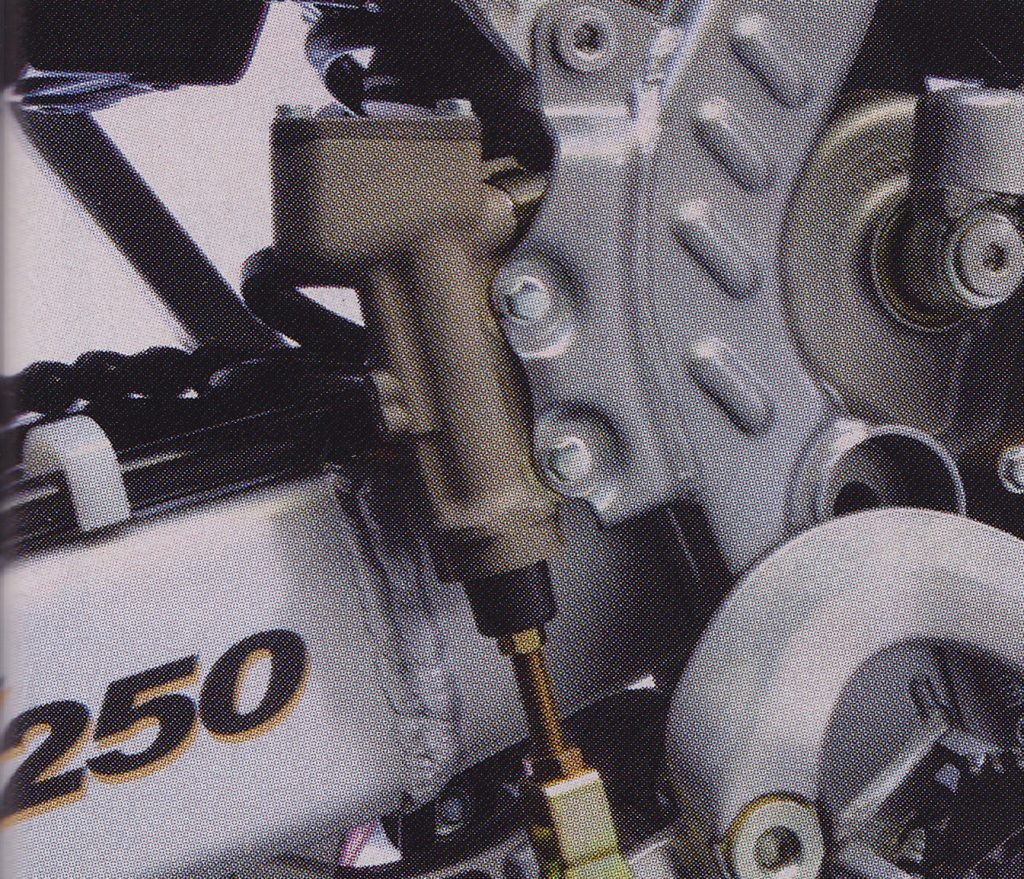 A new integrated rear master cylinder simplified packaging and reduced weight. Photo Credit: Kawasaki
A new integrated rear master cylinder simplified packaging and reduced weight. Photo Credit: Kawasaki
In the details department, the KX250 improved in many areas for 2003. The new bodywork was liked by everyone under six feet tall and the graphics were good looking and the longest-wearing of the Japanese OEMs. The new clamps offered easier access to the pinch bolts and a set of handy eccentric mounts that could be reversed to customize the ergonomics. The stock pipe also came covered in a gray coating that looked cool and wore far better than traditional paint. While not the best combo in the class, the new clutch and trans on the 2003 KX were a big improvement over past Kawasaki efforts.
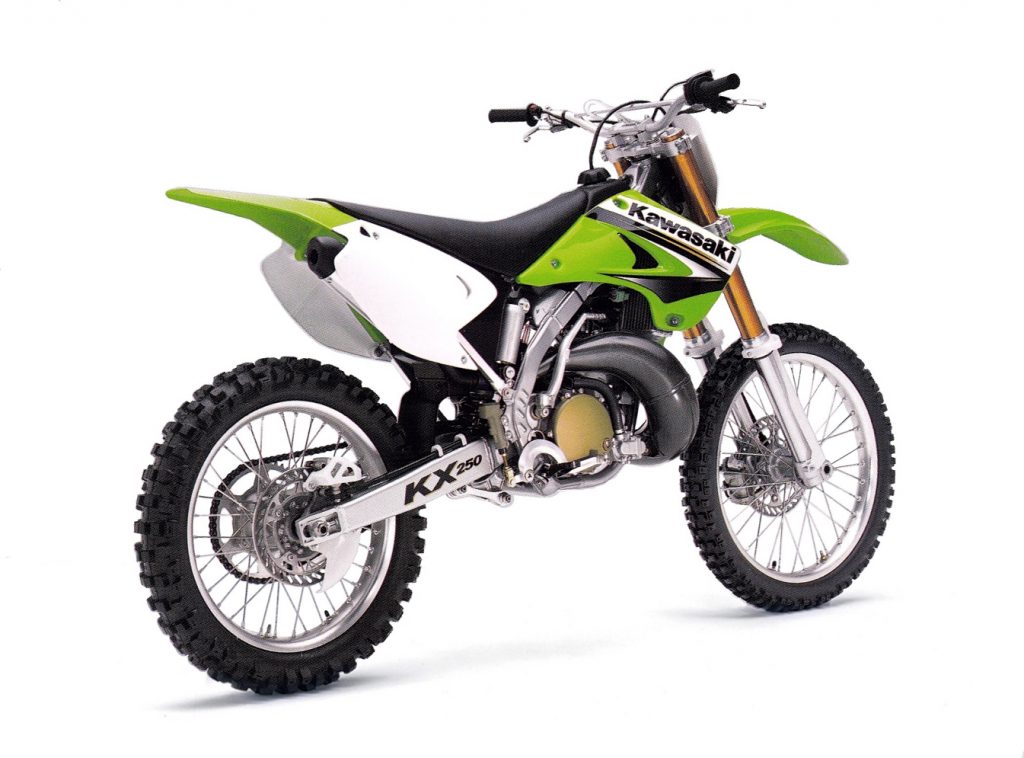 In 2003, the KX250 was all-new and improved in almost every way. Lighter, quicker, and better handling, it was the best KX in four years, but still not the best bike in the class. Photo Credit: Kawasaki
In 2003, the KX250 was all-new and improved in almost every way. Lighter, quicker, and better handling, it was the best KX in four years, but still not the best bike in the class. Photo Credit: Kawasaki
Overall, the 2003 Kawasaki KX250 proved to be a major step forward in most ways over the machine it replaced. Lighter, snappier, and better handling, the ‘03 KX offered a smooth ride and pleasant powerband to those not looking for the fastest or most hard-core ride in the class. For those looking to be the next Ezra or Stew, major mods would need to be budgeted to bring the motor and suspension up to their level, but for Joe Average, the ’03 KX was a solid machine with a ton of potential.
For your daily dose of old school moto goodness, make sure to follow me on Instagram and Twitter @tonyblazier
For questions or comments, feel free to drop me a line anytime at TheMotocrossVault@Gmail.com




